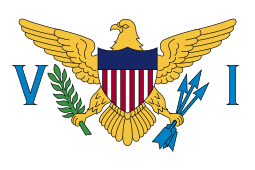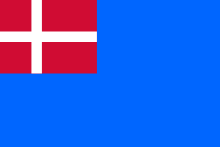Flag of the United States Virgin Islands
The flag of the United States Virgin Islands was adopted on May 17, 1921. It consists of a simplified version of the coat of arms of the United States between the letters V and I (for 'Virgin Islands'). The yellow-colored eagle holds a sprig of laurel in one talon,[1] which symbolizes victory, and three blue arrows in the other (unlike the thirteen arrows in the US coat of arms), which represent the three major islands that make up the U.S. Virgin Islands: Saint Croix, Saint Thomas, and Saint John.[2] When the Virgin Islands were owned by Denmark, the flag was a blue ensign with the Danish flag, or Dannebrog ('cloth of the Danes'), in the canton.
 | |
| Proportion | 2:3 |
|---|---|
| Adopted | May 17, 1921 |
| Design | A simplified version of the coat of arms of the United States between the letters V and I (for Virgin Islands). The yellow-colored eagle holds a sprig of laurel in one talon, and three arrows in the other. The blue color in the shield on the eagle's breast is the same color as that of the flag and shield of the United States. |
History

Prior to Transfer Day 1917, the Danish colonial administration used a simple flag modeled on the blue ensign with the flag of Denmark in its canton. The Danish flag is popularly said to have fallen from the sky during a 1219 battle of the Danish king Valdemar II during the Livonian Crusade against the Estonians.[3] The Scandinavian cross on the flag represents Christianity.[4]
The idea of a U.S. Virgin Islands flag began with the administration of Rear Admiral Sumner Ely Wetmore Kittelle, who was sworn in as governor of the islands on April 26, 1921. He approached Mr. White, captain of the Grebe, and Percival Wilson Sparks, a cartoonist, and asked them for suggestions for a flag design. Sparks immediately drew a design on paper. Afterwards, Sparks transferred it on heavy cotton material, then asked his wife Grace and her sister Blanche Joseph to embroider the design.[5] The later result was what became the United States Virgin Islands flag.
Transfer Day
Transfer Day commemorates the transfer of sovereignty over the islands from Denmark to the United States, which was first marked at an official ceremony in 1917 by the lowering of the Danish flag and the raising of the American flag in Charlotte Amalie.[6][7] The United States had bought the Virgin Islands from Denmark for $25 million, which eventually meant changing the flag to represent the United States.[8]
References
- "The U.S. Virgin Islands Flag". gov.vi. The Government of the U.S. Virgin Islands. Archived from the original on January 28, 1998.
- Harris Evans, Luther. "Virgin Islands".
- "Denmark Flags".
- Andrew Evans. Iceland. Bradt. p. 27. Retrieved 2007-12-31.
Legend states that a red cloth with the white cross simply fell from the sky in the middle of the 13th-century Battle of Valdemar, after which the Danes were victorious. As a badge of divine right, Denmark flew its cross in the other Scandinavian countries it ruled and as each nation gained independence, they incorporated the Christian symbol.
Inge Adriansen, Nationale symboler, Museum Tusculanum Press, 2003, p. 129: "Fra begyndelsen af 1400-tallet kan Dannebrog med sikkerhed dokumenteres som rigsflag, det vil sige statsmagtens og kongens flag" (English: "Dannebrog can with certainty be documented as flag of the realm, that is the flag of the authority of state and of the king, from the beginning of the 1400s") - "US Virgin Islands Flags".
- Hillinger, Charles (March 29, 1987). "Virgin Islands' Special Celebration".
- "Transfer Day in the Virgin Islands: Seven Flags Over St Croix".
- Woolf, Christopher (September 13, 2017). "How a violent history created the US Virgin Islands as we know them".
Further reading
- The Umbilical Cord: The History of the United States Virgin Islands from Pre-Columbian Era to the Present (1995), by Harold W.L. Willocks